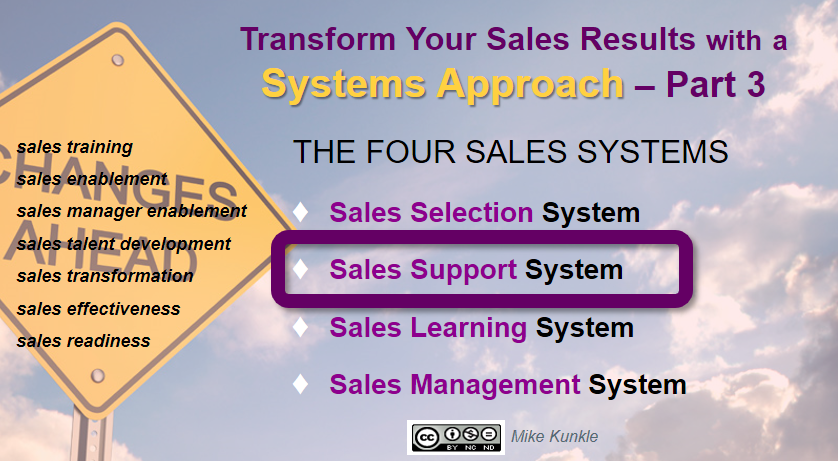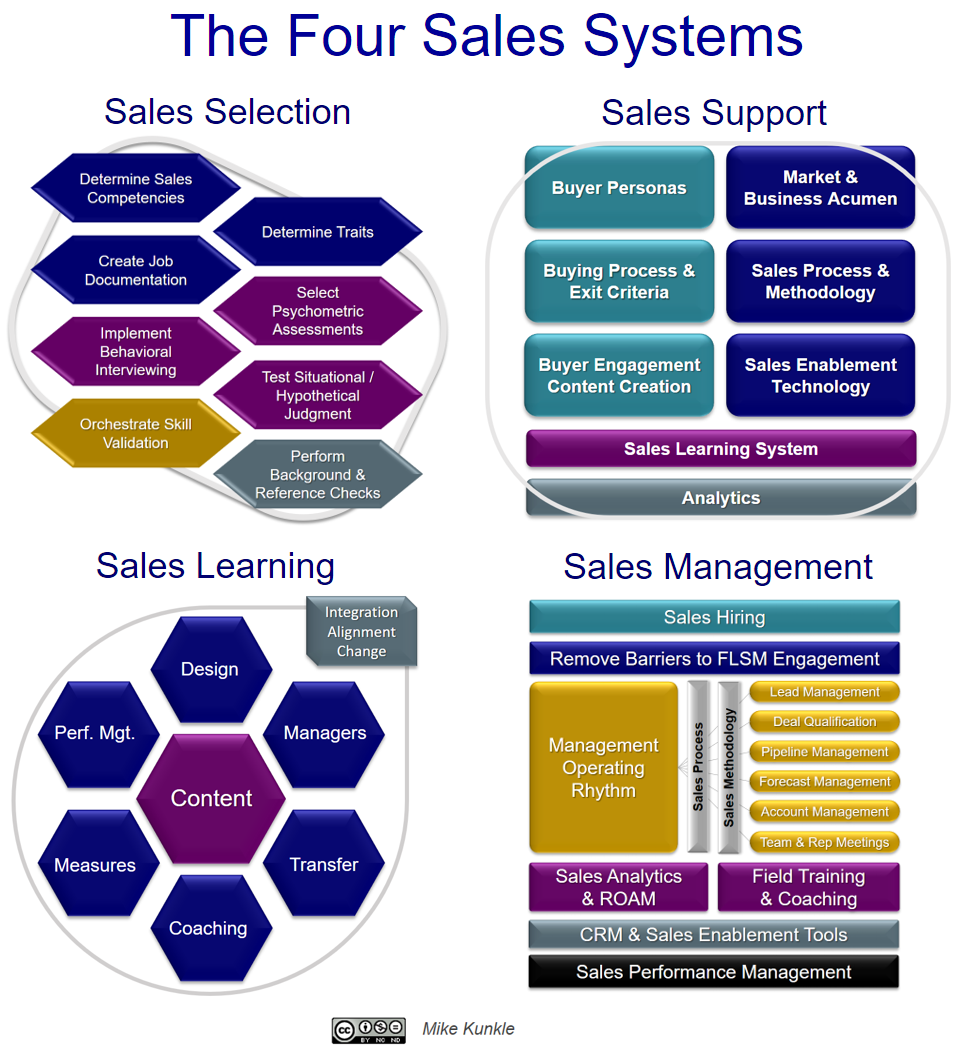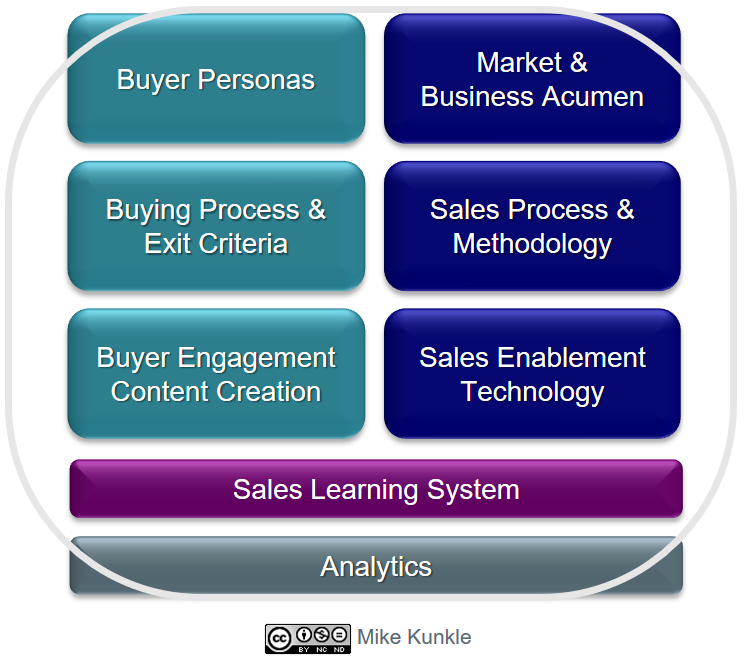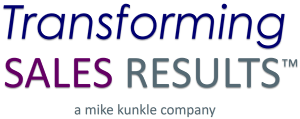Transform Your Sales Results with a Systems Approach – Part 3: Sales Support

In Part 1 of this series, I shared that the solution to our current sales problems and the vehicle for transforming your sales results is a Systems Approach to Sales. The four systems I cited are:

In Part 2 of the series, I highlighted the Sales Selection System.
In this Part 3 post, I will share the details of the Sales Support System.
The Sales Support System

It looks like a lot, but as we walk through the components, I think you’ll see how the puzzle pieces fit together. This system supports both sales readiness and sales enablement.
Buyer Personas: Ensure market and buyer persona knowledge
The first element in the Sales Support System is knowing your market and buyers. You can read elsewhere (like here, here, here and here) about the different approaches to building buyer personas. Good personas include so much more than a “profile” of your buyers, but I still think that concept helps most people grasp what a persona is.
- Who buys from you? What are their roles/titles and responsibilities? What size company are they typically working in?
- What problems, opportunities, and risks (PRO) do they face? What are their needs and wants (relative to the problems you can solve)?
- How are they measured? What are the metrics that really matter?
- What is their typical budget?
- What are the implications of not effectively addressing those PROs?
- What happens if they fail at addressing the PROs? What are the upsides for them, if they do succeed?
- What other pressures are they under?
- Who else in their organization do they typically work with?
- What is their buying process and decision process, when they act to seek solutions?
- What are their decision criteria – what verifiable outcomes and buying process exit criteria are important to them, at each stage of their journey (meaning: what do they need to see, hear, feel, know and/or believe at each stage to feel comfortable moving forward to the next stage of their journey, with you)?
When you think of personas as people, it’s helpful, but remember the difference. Personas provide outstanding intelligence for guiding your marketing efforts, and for preparing sales reps to approach buyers they don’t know a lot about yet. Personas are based on research and data, but they are still amalgams or generalizations. Marketing generally remains a “one-to-many” approach, while sales is “one-to-one” or “one-to-a-few.” When selling, you need to get beyond the initial persona research and assumptions.
Exit criteria for a specific buyer, for example, may be very close to what the persona research indicates, but as a sales professional working with other humans, you need to get to the nitty-gritty of the problems, needs, opportunities, risks, metrics, pressures, politics, emotional factors, and the entire individualized situational analysis – for the real people making the buying decision.
Buying Process & Exit Criteria: Align sales process to buying process with decision/exit criteria
Once you know the buying journey that most of your prospects traverse, you can align your sales process to support it. I don’t want to minimize other aspects of process alignment – this is important work (and often missing or done poorly with an inside-out perspective rather than outside-in). Yet, I place the heaviest emphasis here on preparing to support the buying process exit criteria for your buyers. You can read more about using buying process exit criteria in this post.
I contend that this is the primary work of opportunity management and a key lever for performance improvement. If you understand your buyer’s exit criteria for every stage, as mentioned in the previous section (what do buyers need to see, hear, feel, know and/or believe at each stage to feel comfortable moving forward to the next stage of their journey, with you) it removes the superstition of selling and allows reps to focus on exactly what matters, delivering just what the buyer needs and wants, when they need and want it.
Just as with personas, exit criteria can be documented generally, but when selling, must be discovered and understood for each real buyer on the decision team. While I don’t always call it out specifically by saying “qualification methodology” – that’s what this is (or, it’s part of it, at least). It’s an understanding of the decision criteria for each buyer. Of the myriad of qualification methods available, whichever you use, this must be included to be effective.
Buyer Engagement Content: Create buyer engagement content that aligns with decision/exit criteria
I’m sure you’re seeing that exit criteria is like a needle and thread that weaves through these first few components of the Sales Support System. If you know what buyers generally want to see, hear, feel, know and/or believe in each stage of their buying journey to feel comfortable moving forward with you, you can create marketing and sales content (sales asset management) that’s aimed at satisfying those needs and wants.
What you learn about your buyers – their problems, risks, opportunities, needs and wants – can also fuel your content marketing plan, demand generation approach, and SDR/sales prospecting plans.
Sales Enablement Technology: Use tools to improve efficiency and effectiveness
Years ago, before “sales enablement” was even a phrase, a mentor was fond of saying that “technology is just an enabler.” He was referring to elearning technology at the time, but the sentiment remains true today and certainly applies equally to sales enablement technology. Circa 1995, he may also have been the first person I heard say that “a fool with a tool is still a fool,” which I hear a lot today (and remains true).
I recently worked for a sales enablement solution provider (aka a tool company) and maintain my belief that the right tools, well implemented, can increase both efficiency and sales effectiveness. The challenge is that there are so many tools now, all making wild claims about their impact.
My advice is caveat emptor. Be very clear about what you’re trying to accomplish and support, in advance, and seek purposeful solutions, rather than spending time with every tool vendor who calls, listening to pitches and watching demos for disparate, disconnected solutions. Since stringing tools together can end up somewhere between the Frankenstein monster and a patchwork quilt, I lean toward integrations and vendors who solve multiple problems (when possible) versus a series of point solutions. You need to figure out what’s right for you, but whatever that is, be purposeful. There are limits to budget, sales force mindshare and attention, and the ability to implement and gain adoption.
In my Sales Support System, in this bucket, I tend to focus on tools that:
- Help support a Sales Learning System and Sales Readiness (the Sales Learning System is a component of the Sales Support System, but I will detail that separately in the next post in this series, because there is a lot to it, as a system of its own). In addition to enabling and managing elearning and fostering knowledge sustainment, this might also include:
- Help manage, share, and track content usage, as an enabler for buyer engagement (with content that, of course, supports their exit/decision criteria). It works best if the content can be served up to reps in context of the buying/sales process in their workflow (CRM).
- Help with research, lead generation, and prospecting.
- Serving up training content or reminders, performance support (forms or worksheets), insights, or playbooks, when the reps needs them.
- Providing workflow support for adoption of best practices for lead gen, opportunity management, and strategic account management.
Sales Process & Methodology: Use a buyer-oriented sales methodology
Aside from aligning your sales process to the buying process, and detailing the exit criteria, you also need to detail the stages, objectives, and tasks/steps in the process, teach it to reps (and managers), and support the workflow in CRM (and possibly with others apps).
Despite the importance of and need for sales process work, the real magic happens with your sales methodology.
So – for clarity – the sales process includes the stages a sale moves through, the objectives of each stage, the tasks performed in each, and the desired outcomes of each.
In contrast, the sales methodology is WHAT exactly the reps do in each stage (more detailed than tasks, it’s the models, skills, and behaviors they use) and HOW the reps perform those tasks – meaning how well (the quality) they use the models/skills. In other words, it’s how they sell and how they interact with the buyers – and not just “how” but “how well.”
Without naming names, the bulk of the vendor sales methodologies we hear about most often are incomplete, in my opinion, or at least don’t support the full customer lifecycle.
- A few are aimed at top-of-funnel prospecting and lead gen.
- Many are aimed at how to conduct a sales call (most are outdated for today’s complex B2B enterprise selling environments and team selling).
- Perhaps an equal or slightly fewer number include full opportunity management.
- Far too few focus on strategic account management.
- There are various supporting skills like time management (which is really self- and task-management and organization skills), territory management, delivering compelling and effective sales messaging, conducting business conversations and needs dialogue, using business and financial acumen (needed for the sales conversations/business dialogue and not to be under-estimated; it’s so often missing and is the language of business for executive buyers – see the next component of the Selling System), and more.
- Then there are a smattering of methodologies for things like negotiating, making effective presentations, and other point solutions, as well as newer methodologies like insight selling.
Similar to the tool market, it’s a jumble of options.
Whether you have the expertise internally to build, or you decide to buy, you should examine what your top producers do (to deeply customize) and what industry best practices exist, around every sales/buyer interaction that occurs along your customer lifecycle, from initial account research on one side, to strategic account management on the other. You should have a recommended, “What good looks like” model defined for every major seller/buyer interaction in that lifecycle. Obviously, you should start with whatever is most important right now, based on strategic plans for the year, but you should plan to cover the full lifecycle.
And then, you should ensure that the methodology is modern, buyer-oriented, consultative, solution-focused, and outcome-driven.
I’m not going to detail or recommend specific sales methodologies here, but make no mistake… this is where the magic happens, or doesn’t.
Market and Business Acumen: Train reps to engage buyers in valuable business conversations
This is an outgrowth of the sales methodology, with a similar needle and thread connection, as you saw earlier on the buyer-focused side of the Selling System diagram. To create real value and differentiation, and conduct effective sales/business conversations (including discovery and eventually, solution dialogues), reps must have the business acumen to uncover problems that matter enough to solve and the ability to discuss the value of solutions. To go beyond that, I’d suggest that my Four Pillars of Sales Value Creation come into play here:
- Customer Acumen starts on the left side of the Selling System diagram, with market knowledge and buyer personas, and evolves deeper into a real understanding of your buyers’ business, a complete situation analysis, and an understanding of what matters to each of the decision makers. Proving your interest in them and your deep understanding of their situation is the foundation of credibility and trust – especially when you do so without discussing your solution until you fully understand the problem (which is why I consider patience to be a selling superpower).
- Business and Financial Acumen are almost a ticket to entry in these discussions, if you are going to earn credibility, ask the right questions to uncover problems that matter enough to solve (helping to avoid deal stalls and No Decision status), and understand how their problem impacts the metrics that really matter to them (and next, how your solution will impact those same metrics).
- Solution Acumen includes the ability to select the right solution to the problem, the ability to work with the buyer to co-create the solution or how it will be applied (fostering buy-in and ownership), and the ability to communicate the value of solutions by tying them to the resolution of Problems, Risks, or Opportunities and the attainment of the desired outcomes (again, reflected in the metrics that really matter).
- Operational Acumen may play a smaller role in earlier discussions, but eventually, the ability to navigate complex organizations, relationships, politics, and the knowledge of how to get things done (during the sales process and afterward) in both the selling and buying organizations, provides real value.
I’d be pleased if most reps had the market and business/financial acumen to have valuable sales and business conversations, but when you plug in the Four Pillars, the Sales Support System becomes even more effective (as will your sales reps).
Analytics: Use analytics to track training, content, sales behavior, and outcomes
Whether it’s data from your CRM, LMS, or a separate business intelligence tool with drill-down dashboards, having good analytics is a foundational element that underpins the Selling System. You want to determine the metrics that really matter in terms of learning performance and sales performance – and may want to consider lead and lag indicators for both. Here are just a few examples that I share in another presentation on Sales Onboarding.
In addition, you want to consider each component of the Sales Support System to determine whether you have or want analytics for each, and if so, what they would be.
- You may not need ongoing measures or analytics for buyer personas, for example (although you could track which ones were involved in each deal, which ones most often start deals, or which are most often your Champion or Economic Buyer), but you would want to incorporate a qualification scoring system in your CRM, which took decision criteria and buying process exit criteria into consideration.
- You would want data around the usage and consumption of content during an opportunity cycle, and to eventually try to correlate the use of certain content pieces to win-rates or the progression of opportunities from one stage to the next.
- Business acumen could be measured with an assessment or simulation score.
- For sales methodology, you could use a competency assessment or skills certification program.
I’m sure you get the idea… consider each component of the system and do what makes sense, adds value, and can be tracked, for your business. And of course, the sales metrics are a given. For insight into a dashboard that can be used to help managers determine where to coach for the best results, see this post and slides 8-13 of this SlideShare presentation.
Sales Learning System: Enable the Sales Support System with a Sales Learning System
This is another foundational component of the system. Without the ability to teach, sustain, apply, and master the other components, the system fill fade and fail faster than you can say “poor execution.” The Sales Learning System is the component that perpetuates it all. Which is exactly why I’m going to stop here and detail the Sales Learning System in its own post, next time.
I could certainly have gone deeper on this system, but to prevent this post from becoming an ebook, I’ll stop here and see what reactions or questions I get, and determine if more might be needed, later.
Author Note:
You can find Part 1 here, Part 2 here, Part 3 here, and Part 4 here and Part 5 here.
_________________________________________________
So, as usual, this is what I think. More importantly… What do YOU think?
I’d enjoy hearing your thoughts, experiences, questions, or rants in the comments section. If you enjoy this post, please feel free to share it with others.
Thanks for reading, be safe out there, and by all means… let’s continue to elevate our sales profession and evolve, elevate and professionalize the Sales Enablement function.
Mike Kunkle
:: transforming sales results ::
Let’s get connected:
- This Blog: http://www.transformingsalesresults.com
- LinkedIn Publisher Posts: http://bit.ly/MikeKunklePublisher
- Sales Transformation Straight Talk Webinars: http://bit.ly/STSTonSMM
- The Sales Experts Channel Webinars: http://bit.ly/SalesExpertsChannel
- LinkedIn: http://www.linkedin.com/in/mikekunkle
- Twitter: https://twitter.com/mike_kunkle
- SlideShare: http://bit.ly/MK-slideshare
_____________________________________________________________
sales transformation | sales force transformation | sales training | sales talent development | sales enablement | sales force enablement | sales manager enablement | sales readiness | sales effectiveness | sales optimization








